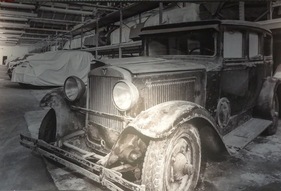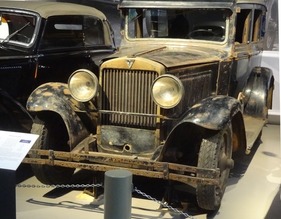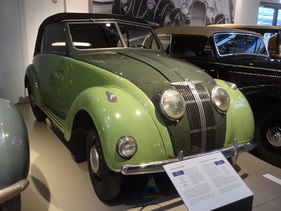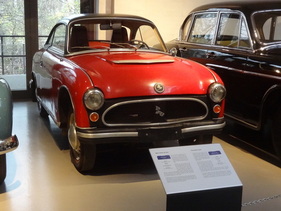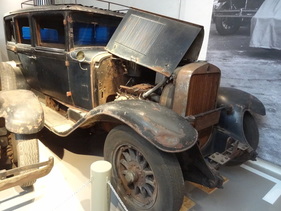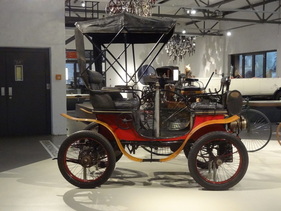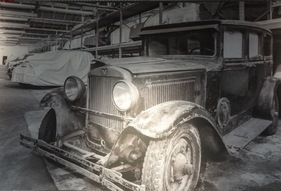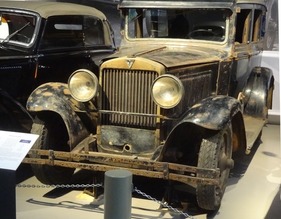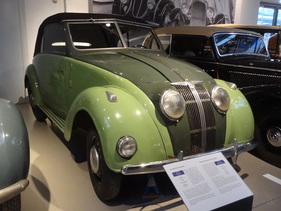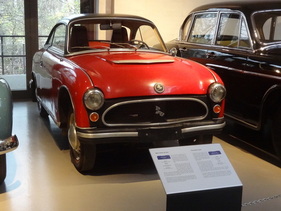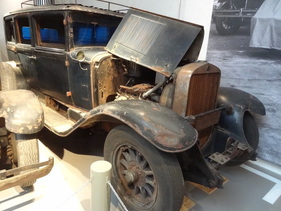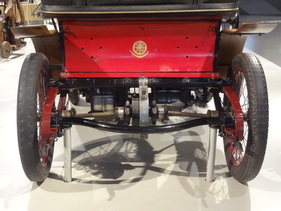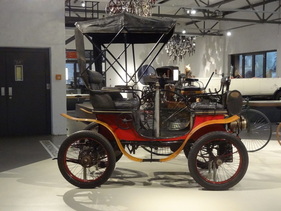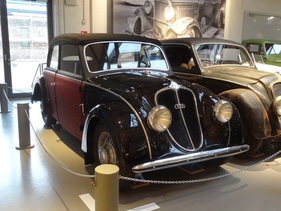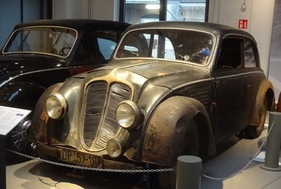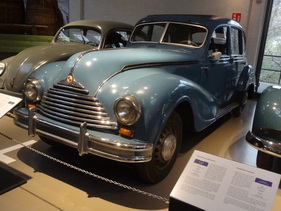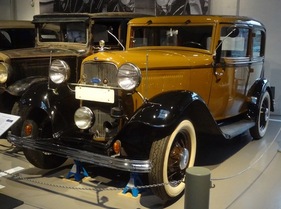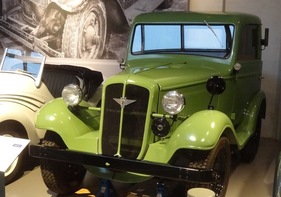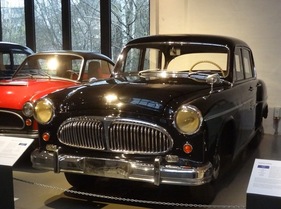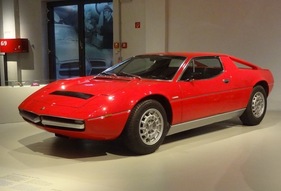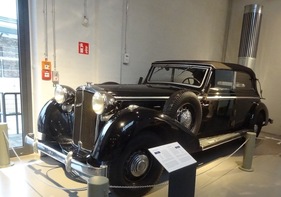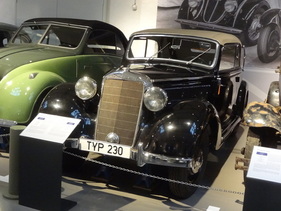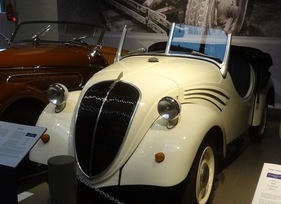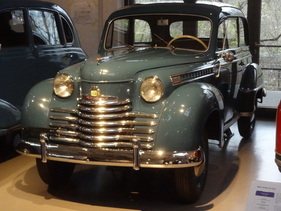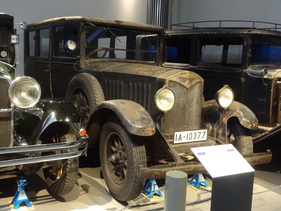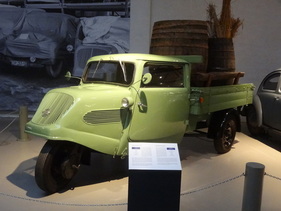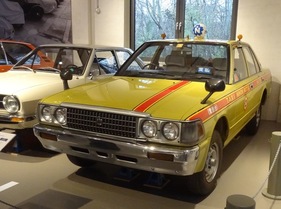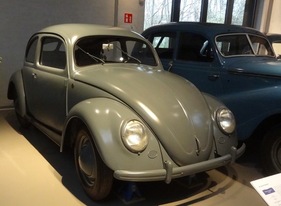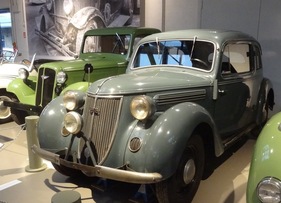Germany has two important technology museums with notable automobile collections: In Munich, there is the Deutsches Museum, founded back in 1903, with the only original Auto Union 16-cylinder (albeit with a new body) and in Berlin, since 1982, the Deutsches Technikmuseum with the "Raisin Bomber" from 1948 as a distinctive feature on the roof.
The automobile collection comprises around 200 vehicles of various origins, from steam, electric, petrol, liquid gas to diesel. Only 30 of them can be shown in the permanent exhibition.
However, a small hall is available for various special exhibitions and since December 6, 2017, it has been the automobiles' turn, which was worth a trip to Berlin for the automobile historian.
Let's start by taking a look inside the depot, where we can see the 1932 Adler Favorit in the large wall photo in the foreground and the covered, two-storey stacked vehicles behind it.
Now walk with me through the exhibition and let me tell you some interesting facts about the vehicles, which I will present in alphabetical order.
Adler Favorit from 1932
Brief description: 1943 cc, 4 cylinders in line, 35 hp, Vmax 80 km/h unrestored original condition
The Adler Favorit appeared in 1929 and had a body influenced by US models. In 1934, its last year of production, it already had a somewhat antiquated appearance, but 12,756 units were still built.
As early as the mid-1930s, chief designer Karl Jenschke began designing and developing the
Adler Type 10 2.5 liter "Autobahn" convertible from 1939
Brief description: 2494 cc, 6 cylinders in series, 58 hp, Vmax 125 km/h restored
This car is the first car built in Germany with a streamlined body, hence the addition "Autobahn". Interesting is the additional headlight on the right and the convertible version, which probably corresponded to the customer's wishes, as it nullifies the streamlined effect when the roof is open. When closed, the Type 10 has a Cd value of 0.36, which corresponds to that of a Golf II from the 1980s. A total of 5295 units were built.
AWZ P 70 Coupé from 1955
Brief description: 684 cc, 2 cylinder two-stroke, 22 hp, Vmax 100 km/h good condition or older restoration
AWZ stands for VEB Automobilwerk Zwickau, better known as the production site of the Trabant, today nostalgically referred to as the Trabi. The type P 70 is the predecessor produced from 1955 with a new pontoon body. Until 1959, a total of 36,000 units were produced as a saloon, estate and coupé. The sedan and station wagon had the later famous Duroplast body on a wooden frame, while the factory management gave the sporty coupé an all-steel body.
Cadillac 341 V8 from 1928
Brief description: 5589 cc, V8 cylinder, 90 hp, Vmax 112 km/h unrestored original condition
Cadillac was taken over by General Motors in 1909 and continued as a separate brand for the top market segment. As early as the 1920s, US customers could order the car in no fewer than 75 versions - customizing. Note the very stable cross bracing between the front frame sections on the vehicle shown here. It is conceivable that the car was registered in Germany, fitted with a wood gas system during the war and then converted back to gasoline.
De Dion rear axle
Everyone has read about De Dion axles in brochures or test reports - few people have ever seen one displayed as openly as this exhibit allows.
While the differential and the axle itself are part of the unsprung mass on the rear rigid axle, De Dion's elegant design connected the differential to the chassis and added it to the sprung mass, which benefited ride comfort. The drive is via half shafts, the lateral forces are supported by the lightweight De Dion tube. In contrast to the swing axle, there is no change in camber during compression.
De Dion-Bouton Type E from 1899
Brief description: 402 cc, 1-cylinder engine, 3.5 hp, Vmax 40 km/h partially restored, static exhibit
It was Carl Benz who designed and built his own frame for his bicycle; all other manufacturers up to the turn of the century replaced the horses with motors and built them into carriages without drawbars - the Horseless Carriage. The vis-a-vis seating arrangement was used for cultivated conversation. In 1902, the Daimler company introduced the Simplex, the first "real" automobile with a radiator in front of the front engine and passengers sitting behind it. De Dion went down in history with the rear axle named after him.
DKW floating class convertible from 1935
Brief description: 1047 cc, 4 cylinder two-stroke, 32 hp, Vmax 95 km/h restored
In the 1920s and from the foundation of Auto Union in 1932, DKW was the manufacturer of low-priced small cars in a simple design. The body consisted of a wooden frame covered with artificial leather, which proved not to be very durable. This was also the reason why DKWs were not confiscated for the Wehrmacht. The body has the beginnings of a streamline. The example shown here has been rebuilt with a new frame and is in perfect condition, albeit at the cost of the original substance.
DKW floating class limousine from 1935
Brief description: 988 cc, 4 cylinder two-stroke, 30 hp, Vmax 90 km/h unrestored original condition
Here is the sister car as a limousine in unrestored original condition, recognizable by the GDR license plate as a utility vehicle used after the war. Well done to the museum that can show such a pair.
EMW 340-2 from 1952
Brief description: 1971 cc, 6 cylinder in-line engine, 55 hp, Vmax 120 km/h unrestored original condition, probably repainted
BMW, the Bayerische Motorenwerke, had automobile production in Eisenach until 1939. In 1945, the plant was placed under Soviet administration and renamed Eisenacher Motorenwerke, the blue and white propeller was changed to a red and white one and production of the 327 continued under the name 327-2. The 340-2 shown here is probably based on the pre-war Type 326 with a slightly modernized body.
Ford B from 1932
Brief description: 3286 cc, 4-cylinder in-line engine, 50 hp, Vmax 105 km/h restored
Ford introduced the all-steel body back in the 1920s, which had advantages over the conventional sheet metal-covered wooden frame in terms of weight, durability and torsional rigidity. However, the all-steel body requires heavy and expensive steel presses, which only pay off when large quantities are produced. The first mass manufacturer Ford naturally had these in its home country, the USA, but not from the outset at its German offshoot Ford Cologne, which, like many other German manufacturers, therefore had the German-American body factory Ambi-Budd in Berlin Halensee produce the bodies and transported them to Cologne.
Hanomag Ss20 tractor from 1938
Brief description: 1910 ccm, 4-cylinder in-line engine (diesel), 20 hp, Vmax 30 km/h restored
The brand name Hanomag developed from the telegram abbreviation "Hanomag" of Hannoversche Maschinenbau AG. In addition to locomotives, trucks and tractors, a number of passenger cars were also manufactured in the 1930s. Hanomag was also one of the diesel pioneers and built the record-breaking diesel car in 1939, which was successfully used on the highway near Dessau. The Hanomag tractor was available in power classes from 20 to 100 hp. The small tractor shown here also had an astonishing pulling power due to its short gear ratio
VEB Kraftfahrzeugwerk Horch P 240 from 1957
Brief description: 2407 cc, 6 cylinder in-line engine, 80 hp, Vmax 140 km/h unrestored original condition, probably repainted
The P 240 was built from 1956 to 1959 at the former Horch factory in Zwickau. Although Auto Union AG and its brands were deleted from the commercial register by the Soviets in 1945, the car still bore the Horch name until 1958. This example survived in West Berlin and made its final appearance in the 1966 film "Funeral in Berlin" as Michael Caine's car.
Maserati Merak from 1980
Brief description: 2998 cc, V-6 cylinder, 220 hp, Vmax 245 km/h restored
The Merak is the little brother of the Bora, it was presented in Turin in 1972 and produced from 1973 to 1982 in various versions with 2- and 3-liter engines. At the end of the production period, there was an SS version with an interior very similar to that of the Bora.
Maybach SW 38, four-door convertible from 1936
Brief description: 3817 cc, 6 cylinder in-line engine, 140 hp, Vmax 140 km/h restored
Maybach Motorenbau, the full name of the manufacturer, was the preferred engine supplier to the Zeppelins. Wilhelm and his son Karl Maybach began producing luxury automobiles after the end of the First World War, when the aircraft industry was severely restricted due to the Treaty of Versailles. Maybach only built rolling chassis and left it up to his customers to have the bodywork built by a company they trusted and to their own taste. Most of the bodies were built during the 1930s by the Spohn company in Ravensburg, near Friedrichshafen.
Mercedes-Benz 230 (W 153), Cabriolet B from 1939
Brief description: 2289 cc, 6 cylinder in-line engine, 55 hp, Vmax 110 km/h, restored from existing parts of various origins
This Type 230 was delivered to Norway, occupied by German troops, in 1940 and returned to Germany in 1972, according to the customs declaration, having been cannibalized. The Cabriolet B shown here was then created from the remains and an existing chassis and body parts. It is not known whether the car was delivered as a convertible or a saloon. It can be described as a new construction using original parts.
NSU Fiat Weinsberg Roadster from 1936
Brief description: 570 cc, 4-cylinder in-line engine, 13 hp, Vmax 86 km/h restored
The Fiat 500 was the first mass-produced small car to be offered in countless versions and body styles. From the sedan to delivery vans, convertibles and the roadster shown here, built by the Weinsberg body factory for the licensee NSU.
Opel Olympia from 1953
Brief description: 1488 cc, 4-cylinder in-line engine, 39 hp, Vmax 112 km/h restored
Introduced in 1935, the Opel Olympia was named after the highly instrumentalized Olympic Games of 1936. The Olympia was innovative in that it was the first car produced in Germany with a self-supporting all-steel body. The body was made from prefabricated steel parts using the spot welding process. This was a decisive departure from the frame construction method, which ultimately originated from carriage building. The Olympia continued to be produced from 1947 to 1953 with a new front axle and fashionable chrome on the radiator.
Protos Type C1 Pullman limousine from 1927
Brief description: 2614 cc, 4-cylinder in-line engine, 45 hp, Vmax 85 km/h unrestored
The Protos company had belonged to Siemens-Schuckert since 1908 and produced only this one upper class model after the First World War. Protos later merged with NAG to form NAG-Protos. The bodies were manufactured by Voll & Ruhrbeck, in this case a so-called Pullman body with separating disk and automatic fire extinguisher to prevent carburettor fires. The car shown here was acquired by a West Berlin collector from the GDR company Interport in 1973 and handed over to the museum.
Tempo Hanseat from 1953
Brief description: Three-wheeled platform truck 400 ccm, 2 cylinder two-stroke, 15 hp, Vmax 50 km/h restored
The concept of the coal merchant Vidal from Hamburg Harburg dates back to the 1920s and was promoted by a law that guaranteed vehicles under 350 cc and less than four wheels were exempt from driving licenses and taxes. Production continued after the war and by the mid-fifties over 100,000 Tempo three-wheelers had been registered in the Federal Republic.
Toyota Crown E-VS 130 from 1987
Brief description: 1998 cc, 4-cylinder in-line engine, 82 hp, Vmax 135 km/h unrestored original condition
This Toyota cab was acquired by the Museum of Technology in 1995 for a cab exhibition in Japan. It has covered 438,859 km and is in original condition, right-hand drive and with LPG drive.
VW Type 11 Standard "Pretzel Beetle" from 1952
Brief description: 1131 ccm, 4 cylinder boxer engine, 25 hp, Vmax 105 km/h restored standard gray matt paint finish
Created as a KdF car, paid for by hundreds of thousands with savings cards and eagerly awaited, the car called the Volkswagen after the end of the war made it onto the market after a delay of almost ten years and became the most produced automobile by the end of production. The "Beetle" was available in a simple standard version with cable brakes and in a slightly more upmarket version with hydraulic brakes as an export. The vehicle on display here has been restored and initially given a gloss paint finish. To give it an authentic appearance, it was given a contemporary matt paint finish.
Wanderer W24 from 1937
Brief description: 1767 cc, 4-cylinder in-line engine, 42 hp, Vmax 105 km/h good condition or older restoration
Alongside Audi, DKW and Horch, Wanderer is the fourth ring of the Auto Union logo, which today everyone recognizes only as Audi. Wanderer cooperated closely with DKW in the 1930s with regard to the all-steel body. As is well known, DKW stuck with the two-stroke engine until it was taken over by Audi, while Wanderer fitted the car with a four-cylinder, four-stroke engine. By the beginning of the war, 22,488 units had been built in various versions.
The exhibition is certainly worth a visit for anyone traveling to Berlin!
The special exhibition "Umgeparkt - Autos aus dem Depot" can be seen at the Deutsches Technikmuseum Berlin between December 6, 2017 and July 31, 2018.
Further information can be found on the website.





















































